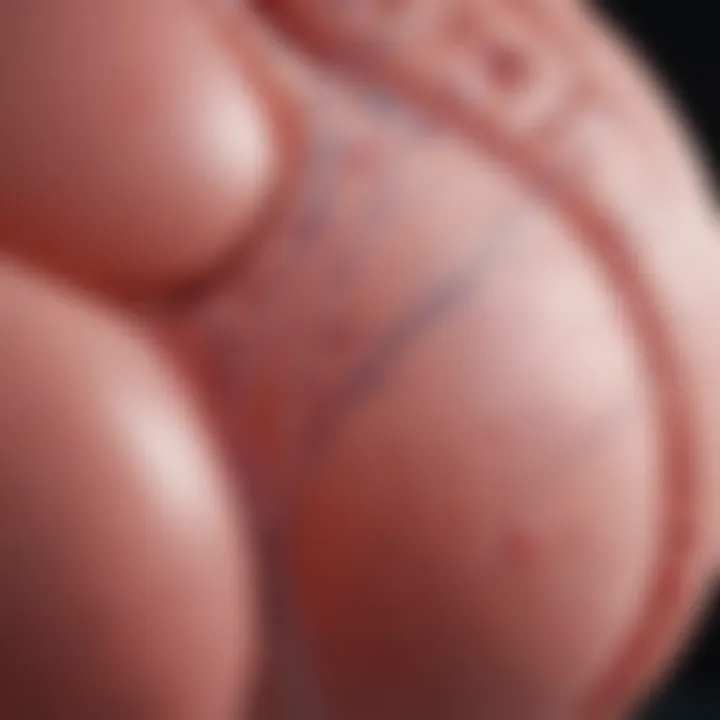Impact of Balloon Angioplasty: A Comprehensive Study


Intro
Balloon angioplasty represents a significant advancement in interventional cardiology. The procedure aims primarily to restore flow in arteries that have narrowed or become obstructed due to various cardiovascular diseases. The impact of this technique extends beyond mere procedural success; it touches various aspects of patient care and outcomes.
The complexities involved in understanding the implications of balloon angioplasty require an exploration of its effectiveness, advancements in technology, and the long-term results for patients. This article synthesizes existing research and clinical data to provide a well-rounded overview of the topic.
Research Overview
Summary of Key Findings
Balloon angioplasty has been shown to significantly reduce symptoms in patients suffering from coronary artery disease. Studies indicate that the procedure improves quality of life and, in many cases, can lead to better survival rates. The recent advancements in angioplasty techniques and materials have further enhanced procedural outcomes. For instance, the use of drug-coated balloons has emerged as a pivotal development that helps to minimize the risks of restenosis, or the re-narrowing of arteries.
An analysis of patient outcomes reveals that those undergoing balloon angioplasty often experience a marked reduction in angina symptoms. Additionally, the rate of major adverse cardiac events, including heart attacks, has decreased in numerous studies. Duration of the effect varies, but many patients enjoy relief for extended periods following the intervention.
Relevance to Current Scientific Discussions
The findings surrounding balloon angioplasty are integral to modern discussions in cardiovascular medicine. With an increased focus on patient-centered outcomes and evidence-based practices, this technique is becoming more critical in the clinical landscape. Researchers and healthcare professionals are continually evaluating its effectiveness in comparison to other approaches, such as coronary artery bypass grafting (CABG) and newer treatments involving stents.
The ongoing discourse also addresses the cost-effectiveness of balloon angioplasty versus alternatives, especially in an era where healthcare resources are increasingly under scrutiny. By understanding both the short and long-term effects of this technology, practitioners can make more informed decisions regarding patient treatment plans.
Methodology
Research Design and Approach
A comprehensive literature review was conducted to gather data on balloon angioplasty outcomes. The analysis included peer-reviewed articles, clinical trials, and meta-analyses published in prominent medical journals. The objective was to synthesize varied perspectives and findings to present a holistic view of the technique's impact.
Data Collection and Analysis Techniques
For effective data collection, multiple databases were searched, including PubMed and Cochrane Library. Keywords such as "balloon angioplasty,” "patient outcomes,” and "long-term effects" were utilized. Data from these sources were then analyzed to identify trends and discrepancies within the body of research.
The analysis process involved qualitative methods to understand the nuances in patient experiences and quantitative approaches to assess statistical significance in outcomes. This mixed-methods strategy ensured a robust understanding of the effectiveness and ramifications of balloon angioplasty.
Prelude to Balloon Angioplasty
Balloon angioplasty is a critical intervention in modern medicine, specifically in the field of cardiology. This procedure plays a fundamental role in alleviating symptoms associated with arterial blockages, improving patient quality of life, and potentially extending survival rates in certain populations. Understanding the nuances of balloon angioplasty allows healthcare professionals to better evaluate treatment options available for patients suffering from conditions like coronary artery disease and peripheral artery disease. This section will elucidate the definition and purpose of balloon angioplasty, as well as its historical evolution, which collectively provide context for its current clinical applications and future prospects.
Definition and Purpose
Balloon angioplasty is a minimally invasive procedure that intends to widen narrowed or obstructed blood vessels. It involves the insertion of a balloon catheter into the affected artery, followed by inflation of the balloon at the site of blockage. This inflation compresses the plaque against the arterial wall, resulting in an increased diameter of the vessel lumen. The primary purpose of balloon angioplasty is to restore adequate blood flow, which can relieve symptoms such as chest pain and improve overall cardiovascular health. This restoration of blood flow has significant implications for patients as it can enhance their exercise capacity, reduce the need for medications, and improve their quality of life.
Historical Background
The origins of balloon angioplasty trace back to the late 20th century. Andreas Gruentzig pioneered the first balloon angioplasty procedure in 1977. His innovative approach transformed the treatment of coronary artery disease, offering an alternative to more invasive surgical procedures such as coronary artery bypass grafting. Since its inception, balloon angioplasty has undergone substantial advancements in techniques and technology. Early iterations faced issues with restenosis, or the re-narrowing of arteries, prompting the development of stenting to maintain vessel patency. Today, balloon angioplasty is widely recognized as a standard treatment in interventional cardiology, demonstrating its efficacy and value in a clinical setting.
Mechanism of Action
Understanding the mechanism of action behind balloon angioplasty is crucial for appreciating its role in treating vascular disorders. This procedure alleviates the obstruction in arteries. The fundamental concept relies on the physical dilation of the affected artery using a balloon catheter. By expanding the arterial lumen, blood flow is restored, thereby alleviating symptoms associated with reduced perfusion such as angina or claudication.
The careful orchestration of the process necessitates a solid grasp of the anatomy involved and the procedural details, which substantially impact outcomes. The effectiveness of balloon angioplasty is dictated by both the technique employed and the anatomical characteristics of the artery under treatment. Therefore, a meticulous approach is necessary to minimize complications and ensure optimal results.
Anatomy of the Affected Artery
In balloon angioplasty, the anatomy of the affected artery plays a significant role. The most commonly involved arteries include coronary arteries and peripheral arteries.
The coronary arteries supply blood to the heart muscle. Their health is crucial since blockages can lead to heart attacks. On the other hand, peripheral arteries are vital for blood flow to limbs. Both types are susceptible to atherosclerosis, causing plaque buildup. Understanding the site of obstruction and the nature of the blockages influences the approach during the procedure.
Key aspects of the artery's anatomy include:
- Lumen Size: The diameter of the artery directly impacts the choice of balloon size.
- Elasticity: The ability of the artery to stretch is essential for successful dilation.
- Length of Lesion: Longer lesions may require different strategies compared to shorter ones.
Procedure Details


The procedure involves several key phases, each critical for its success. The main components of the procedure include preparation, catheterization, and balloon inflation and deflation.
Preparation and Anesthesia
Preparation for balloon angioplasty begins with a thorough assessment of the patient's medical history and symptoms. This assessment helps to identify the most appropriate approach. Anesthesia, typically local, is used to minimize discomfort during the procedure. This aspect is vital because it allows the patient to remain awake, facilitating monitoring and ensuring rapid communication with the medical team.
The key characteristic of anesthesia in this context is its localized application, which makes it a beneficial choice for minimizing systemic effects. This method avoids the complications associated with general anesthesia, such as prolonged recovery times. One unique feature of local anesthesia is its rapid onset, allowing surgeons to initiate the procedure without delay.
Catheterization Process
The catheterization process is a critical step in balloon angioplasty. This involves inserting a thin, flexible tube through a blood vessel, usually in the groin or wrist, and threading it to the site of blockage. The key characteristic of this process is its minimally invasive nature, which reduces recovery time and complication risks.
A unique feature of catheterization is the use of fluoroscopy. This imaging method guides the physician in real-time, helping navigate the catheter effectively. Although the risk of complications exists, such as bleeding or vascular injury, the benefits far outweigh these concerns, given the potential for successful intervention.
Balloon Inflation and Deflation
Balloon inflation and deflation is the crux of the procedure, literally pushing the blockage aside. Once positioned, the balloon is inflated at specific pressures to widen the artery. The characteristic aspect of this step is its rapid effect on restoring blood flow. It is a beneficial choice as it provides immediate results in many cases.
The deflation phase is equally important. Upon achieving adequate dilation, the balloon is deflated, allowing the artery to maintain its expanded state. One unique feature here is how the surrounding tissue adapts, often enhancing the treatment's long-term success. However, there are disadvantages to consider; sometimes the artery can recoil, leading to potential complications in the months following the procedure.
Thus, both the immediate and lasting effects hinge on various factors, including the nature of the artery and the overall health of the patient.
The procedural details, from preparation to inflation, form a cohesive framework that underpins the success of balloon angioplasty. Each step entails strategic considerations that ultimately contribute to patient outcomes.
Indications for Balloon Angioplasty
The indications for balloon angioplasty are critical to understanding its role in managing cardiovascular diseases. As a minimally invasive procedure, balloon angioplasty is indicated primarily for patients suffering from narrowed or blocked arteries, largely due to atherosclerosis. Identifying these indications is essential for clinicians to provide effective treatment.
Coronary Artery Disease
Coronary artery disease (CAD) serves as the foremost indication for balloon angioplasty. In CAD, the blood vessels supplying the heart muscle become narrowed or blocked due to plaque buildup. Symptoms may include chest pain, shortness of breath, or even silent ischemia.
The decision to proceed with balloon angioplasty in CAD cases often hinges on the severity of the narrowing and the patient’s overall health.
Key factors include:
- Degree of blockage: A blockage of 70% or more in major arteries typically indicates the need for intervention.
- Symptoms: Presence of significant symptoms that impact the quality of life can prompt angioplasty.
- Risk factors: Those with diabetes, hypertension, or high cholesterol may be more inclined to require this procedure.
- Previous treatment efficacy: If prior treatments, such as medication and lifestyle changes, have not adequately alleviated symptoms, angioplasty becomes a viable option.
The benefits of angioplasty in CAD are substantial. Research shows that it can lead to immediate relief of symptoms and improvements in heart function. However, long-term outcomes depend on the overall management of the patient's health post-procedure.
Peripheral Artery Disease
Peripheral artery disease (PAD) is another major indication for balloon angioplasty. PAD affects blood flow to the limbs, particularly the legs, and can result in claudication, which causes pain during physical activity.
Signs of PAD might include:
- Leg pain during walking: Patients often report aching, cramping, or fatigue in their muscles during activity.
- Weak pulses in the legs: This indicates decreased blood flow.
- Coldness in the lower leg or foot: May arise due to diminished circulation.
In cases of severe PAD that do not respond to conservative management, balloon angioplasty can indirectly improve the quality of life. The procedure can be performed on the femoral, popliteal, and tibial arteries to restore blood flow.
The outcomes of angioplasty in PAD patients are generally favorable. Increased blood flow can enhance mobility, reduce symptoms, and generally improve physical functioning. As with CAD, long-term results will depend on managing underlying conditions and continuous follow-up care.
In summary, balloon angioplasty is indicated for both coronary artery disease and peripheral artery disease, offering significant benefits in symptom relief and quality of life improvements for affected patients.
Understanding these indications helps clinicians determine suitable candidates and tailor appropriate interventions to improve patient outcomes.
Clinical Effectiveness
The clinical effectiveness of balloon angioplasty is a crucial aspect to consider when evaluating its role in modern cardiology. This procedure has significantly transformed how medical professionals manage arterial blockages, particularly those associated with coronary artery disease and peripheral artery disease. Balloon angioplasty swiftly restores blood flow, thereby reducing the risk of serious complications like heart attacks or limb ischemia. It is essential to assess both short-term recovery times and long-term outcomes to gauge the overall impact on patient health.
Recovery from balloon angioplasty tends to be relatively swift compared to more invasive procedures. Most patients can expect to leave the hospital within a day, often resuming normal activities shortly thereafter. The focus on less invasive techniques not only improves patient comfort but also minimizes surgical risks. Careful monitoring of recovery times helps healthcare providers understand patient tolerances and ensure effective rehabilitation.


Outcomes related to balloon angioplasty generally reflect its efficiency. Many studies indicate that a significant number of patients experience relief from symptoms such as chest pain or claudication after the procedure. However, effectiveness also depends on patient-specific factors, including the extent of arterial disease and overall health.
Recovery Times and Outcomes
The recovery period after balloon angioplasty varies among individuals but is generally modest. Patients typically stay in a short-stay unit for monitoring, often for about six to 24 hours, depending on their individual circumstances. Discharge usually occurs on the same day or the following day. Physicians provide guidelines for resuming activities, emphasizing the importance of avoiding heavy lifting or strenuous exercise initially.
The immediate outcomes are noteworthy; many patients report improved well-being shortly after the procedure. Studies indicate a noticeable decrease in angina episodes and improved exercise tolerance, which can significantly enhance quality of life. However, continued follow-up is pivotal to evaluate long-term success rates, including any potential need for repeat interventions.
Comparison with Other Treatments
Assessing balloon angioplasty's effectiveness requires comparison with alternative treatments. Two common comparable procedures include stenting and coronary bypass surgery.
Stenting
Stenting often follows balloon angioplasty to maintain arterial patency. The stent acts as a scaffold, supporting the artery wall post-procedure. One of stenting’s key characteristics is its ability to reduce the likelihood of restenosis, a common issue where arteries narrow again post-angioplasty. Stenting is considered a beneficial option because it allows for a minimally invasive approach, leading to faster recovery times compared to surgical options.
However, stenting is not without its drawbacks. The need for long-term antiplatelet therapy increases risks of bleeding and requires patient adherence to medication regimens. Moreover, adverse reactions to materials used in stent construction can occur in some cases.
Coronary Bypass Surgery
Coronary bypass surgery is a more invasive procedure that involves rerouting blood around blocked arteries. This method is often recommended for patients with severe coronary artery disease involving multiple vessels. The key feature of coronary bypass surgery is its comprehensive approach to restore blood flow.
The advantage of bypass surgery is its long-term effectiveness; many studies suggest that it may offer better outcomes for certain populations over balloon angioplasty, especially in patients with complex blockages. Nevertheless, it carries higher immediate risks, longer recovery times, and greater hospitalization durations, making it less favorable for those who may benefit from a less invasive method.
Risks and Complications
Understanding the risks and complications associated with balloon angioplasty is critical in the overall evaluation of this procedure. While balloon angioplasty is generally considered safe and effective, like any invasive treatment, it is not without its potential drawbacks. Awareness of these risks allows healthcare professionals to manage them better and inform patients adequately before the procedure.
Common Complications
Balloon angioplasty can lead to several common complications, which vary in severity. Here are some of the most significant:
- Restenosis: This is the re-narrowing of the artery after the procedure, affecting a notable percentage of patients. Factors influencing restenosis include the original severity of blockage and the frequency of follow-up treatments.
- Dissection: This occurs when the arterial wall is damaged during catheter insertion, potentially leading to blockage or rupturing.
- Thrombosis: The formation of a blood clot in the treated area can occur, which may lead to acute coronary events if not addressed promptly.
- Allergic Reactions: Some patients might experience allergic reactions to the contrast dye used during the procedure, necessitating attention.
- Infection: As with any procedure, there is a risk of infection at the catheter insertion site, particularly if post-operative care guidelines are not followed.
Being cognizant of these potential complications, clinicians can be proactive in monitoring patients and implementing timely interventions when necessary.
Prevention Strategies
Employing effective prevention strategies plays a vital role in minimizing the risks associated with balloon angioplasty. Key strategies include:
- Thorough Pre-screening: Comprehensive assessments including medical history and risk factor evaluation can help identify patients who may be at increased risk for complications.
- Use of Antiplatelet Agents: These medications, such as aspirin and clopidogrel, can be administered before and after the procedure to reduce the likelihood of thrombus formation.
- Technical Precision: Surgeons must adhere to best practices during catheterization and balloon inflation to reduce incidents of dissection and other mechanical complications. Employing imaging technologies can aid in enhancing procedural precision.
- Postoperative Care: Ensuring proper follow-up care, including monitoring vital signs and conducting regular check-ups, is essential for early detection of any complications.
- Patient Education: Informing patients about signs of potential complications and encouraging adherence to follow-up appointments can enhance patient outcomes.
"The awareness of the complications related to balloon angioplasty not only aids in patient safety but also enhances the overall success of treatment outcomes."
Thus, understanding and implementing these strategies can significantly mitigate risks, reinforcing the safety of balloon angioplasty as a therapeutic intervention.
Patient Selection Criteria
The patient selection criteria for balloon angioplasty plays a critical role in determining the success of the procedure. Identifying suitable candidates is vital to ensure effective treatment outcomes. The selection process involves a careful analysis of patient history, symptoms, and overall health condition. This assessment can highlight potential risks and benefits associated with the procedure. Understanding whom to select can optimize the chances of positive results from balloon angioplasty while reducing complications.
Factors Affecting Eligibility
Multiple factors can influence patient eligibility for balloon angioplasty. These factors include:
- Age: Younger patients tend to have better outcomes, while older individuals may face increased risks due to comorbidities.
- Severity of Disease: The extent of artery blockage is crucial. Patients with significant narrowing may benefit more than those with mild symptoms.
- Underlying Health Conditions: Conditions like diabetes, hypertension, and heart failure can complicate the procedure and should be considered.
- Lifestyle Factors: Smoking status and physical activity play a role in recovery and overall health. Those who lead sedentary lifestyles may have different outcomes than more active individuals.
- Previous Interventions: A patient's history with prior interventions can affect the decision-making process. For instance, previous stent placements may alter the approach.
It is essential for healthcare providers to evaluate these factors when considering a patient for balloon angioplasty. A comprehensive evaluation allows for tailored treatment plans that maximize effectiveness while mitigating risk.
Importance of Pre-procedural Assessments
Pre-procedural assessments are an integral part of selecting patients for balloon angioplasty. These evaluations ensure that candidates are adequately prepared for the procedure. Key components include:


- Cardiac Imaging: Tests such as angiograms provide detailed visualizations of arterial blockages. They help assess the severity and location of the issue, guiding treatment decisions.
- Laboratory Tests: Blood work can reveal underlying issues, such as elevated cholesterol or diabetes, that may impact healing and recovery.
- Health History Review: Understanding a patient's complete medical history, including medications and previous surgeries, is crucial. This knowledge can prevent complications during and after the procedure.
- Risk Assessment: Stratifying the risk based on gathered information allows healthcare providers to predict potential complications. Higher-risk patients may require alternative interventions or more intensive monitoring.
Overall, pre-procedural assessments are essential in the patient selection process. They ensure that only those most likely to benefit from balloon angioplasty proceed with the intervention, ultimately improving patient safety and outcomes.
Long-term Outcomes
Long-term outcomes of balloon angioplasty are critical for understanding the overall effectiveness and sustainability of this intervention in patients with cardiovascular diseases. While the immediate goals of balloon angioplasty include widening narrowed arteries and restoring blood flow, assessing the long-term implications provides deeper insights into patient recovery and ongoing healthcare strategies. Evaluating long-term outcomes is essential as it not only affects individual treatment plans but also has broader implications for healthcare systems.
Recurrence of Symptoms
Recurrence of symptoms is a significant concern following balloon angioplasty. Patients may experience a return of angina or symptoms associated with peripheral artery disease. This can stem from various factors such as underlying coronary artery disease, inappropriate patient selection, or the development of scar tissue within the artery where the procedure was performed. Studies indicate that approximately 30% to 40% of patients can experience recurrent symptoms within five years post-angioplasty.
Monitoring is vital to detect these recurrences promptly. Through regular follow-up appointments and the use of non-invasive imaging techniques, clinicians can assess the vascular health of patients post-procedure. Lifestyle modifications, medical therapy, and in some cases, additional interventions may be recommended if symptoms recur.
"The challenge of symptom recurrence emphasizes the need for comprehensive post-procedural care, ensuring patient education and adherence to treatment plans."
Quality of Life Considerations
Quality of life post-balloon angioplasty holds substantial importance in evaluating the intervention’s overall success. Improvements in symptoms often translate to a better quality of life for patients. Many studies highlight how patients report favorable outcomes in their day-to-day activities and satisfaction with treatment following the procedure.
Factors influencing quality of life include physical capabilities, emotional well-being, and social interactions. Patients are likely to gain confidence in their ability to engage in normal activities without the burden of pain or discomfort. However, it’s critical to recognize not all patients experience the same levels of improvement. Some may continue to struggle with psychological impacts, such as anxiety related to the potential for another cardiovascular event.
Investing in long-term support systems, including rehabilitation programs and counseling, can enhance quality of life for many individuals, allowing them to navigate the challenges associated with their health status.
In summary, the long-term outcomes of balloon angioplasty underscore the importance of not only treating the immediate physiological problems but also considering the comprehensive well-being of patients. Positive long-term outcomes can lead to enhanced life quality, but continual assessment and support remain essential.
Technological Advancements
Technological advancements play a critical role in enhancing the efficacy and safety of balloon angioplasty. This section explores specific innovations that have contributed to improvements in both patient outcomes and procedural success rates, highlighting the importance of these developments in modern interventional cardiology.
Innovations in Balloon Design
The evolution of balloon design has significantly impacted the success of angioplasty procedures. Traditional balloon catheters, while effective, were limited in their ability to address complex lesions. Newer balloon technologies, such as drug-coated balloons, have emerged to enhance the ability of the procedure to reduce the risk of restenosis. These balloons deliver medication directly to the arterial walls during inflation, promoting healing and preventing the regrowth of tissue that can lead to blockages.
Additionally, advancements in materials science have led to the development of ultra-thin and highly compliant balloon catheters, which allow for more precise navigation through tortuous vascular pathways. The incorporation of hydrophilic coatings has also improved the ease of catheter navigation, minimizing trauma to the vessel walls. By providing greater flexibility and adaptability, these innovations enhance the overall effectiveness of the angioplasty procedure.
"Innovative balloon designs not only improve procedural outcomes but also contribute significantly to the long-term health of patients undergoing angioplasty."
Integration of Imaging Technologies
The integration of advanced imaging technologies into balloon angioplasty practices has transformed procedural guidance and patient monitoring. Techniques such as intravascular ultrasound (IVUS) and optical coherence tomography (OCT) provide real-time imaging of the arterial lumen and vessel wall. This enhanced visualization allows clinicians to make more informed decisions during the procedure, ensuring optimal balloon placement and inflation.
Furthermore, advanced imaging aids in the assessment of plaque characteristics and the degree of arterial stenosis prior to intervention. By allowing for precise measurement and analysis, imaging technologies contribute to tailoring the angioplasty approach for individual patients. This personalized approach has the potential to improve outcomes and reduce complications associated with balloon angioplasty.
In summary, technological advancements in both balloon design and imaging integration are essential for enhancing the effectiveness of balloon angioplasty. These innovations not only improve immediate procedural outcomes but also support long-term patient health and recovery.
Future Directions in Research
The exploration of balloon angioplasty has led to significant improvements in clinical practice and patient outcomes. It is crucial to consider future directions in this field. Understanding emerging research and innovations will not only enhance procedural effectiveness but can also optimize patient care. Researchers and healthcare professionals must focus on several key areas to push the boundaries of what is currently possible.
Emerging Techniques
Recent advancements have introduced novel techniques aimed at improving balloon angioplasty outcomes. Techniques such as drug-coated balloons have shown promise in reducing the restenosis rate, which is a common complication. Drug-coated balloons deliver medication directly to the vessel wall, minimizing the chance of the artery narrowing again after the procedure.
Other emerging methods include the use of peripheral vascular interventions. These approaches target more complex vascular conditions that have not responded well to traditional angioplasty. The development of bioresorbable scaffolds is also on the rise. These scaffolds provide temporary support to the artery and dissolve over time, which can aid in healing and reduce long-term complications.
Potential for Bioengineered Solutions
Bioengineered solutions represent a frontier that holds significant potential in the field of cardiovascular interventions. Researchers are investigating materials that can actively respond to the biological environment of the artery. These solutions can foster better healing and integrate seamlessly with the vascular system.
This area of research involves the development of bioengineered grafts and conduits. Such innovations could address the limitations of current materials used in angioplasty and stenting. Moreover, the potential to regenerate vascular tissue using stem cells or tissue engineering techniques offers a long-term solution to arterial blockages.
Research in bioengineered solutions could revolutionize approaches to vascular disease management, significantly improving patient outcomes.
By focusing on these advancements, the field of balloon angioplasty can evolve. The continuous effort to innovate will ensure that future patients benefit from safer and more effective interventions.
As research progresses, it is essential to maintain a strong emphasis on clinical trials and evidence-based practices. Continuous collaboration between research institutions, healthcare providers, and industry stakeholders will pave the way for a brighter future in interventional cardiology.



